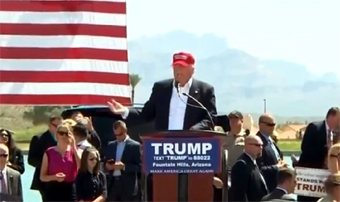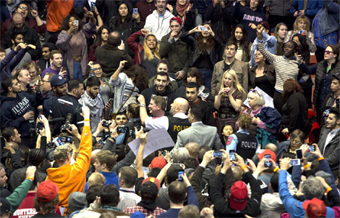
Trump appearing at rally in Arizona/Images courtesy of C-Span
Violence & Mayhem Increases at
Trump Campaign Rallies
| published March 20, 2016 |
By R. Alan Clanton, Thursday Review editor
The violence inside and outside rallies for Republican Presidential candidate Donald Trump has become more commonplace this weekend, with incidents in multiple cities and states, even as GOP officials and non-official movers-and-shakers plot and organize in an attempt to block his nomination in July.
The Washington Post is reporting that Trump will meet Monday morning with officials of the Republican National Committee to discuss both sides’ mutual concerns—especially, some party insiders suggest, Trump’s continued talk of violence and riots if he is denied the party’s nomination.
Appearing on ABC News’ “This Week” early on Sunday, Trump was asked bluntly about those conservative groups, party elders, and establishment groups who are moving to outflank him prior to the convention.
“I don’t know what’s going to happen,” Trump said on ABC, “but I will say this—you’re going to have a lot of unhappy people. I don’t want to see riots, I don’t want to see problems. But you’re talking about millions of people.”
The comments come at a time when news coverage of Trump events now routinely include video footage and photos of violence—some of it instigated by anti-Trump demonstrators, some of it triggered by pro-Trump fans. Trump is now being blamed for some of these incidents, including a rally in North Carolina where law enforcement is considering charging Trump with inciting a riot. Recent news footage shows Trump’s campaign manager, Corey Lewandowski, manhandling one protester by grabbing his shirt and slinging him out of the way. Lewandowksi may also still be facing charges in a recent incident in which he roughed up a reporter.
Over the weekend, the incidents of violence reached a fever pitch across the map.
Supporters and opponents of the front-runner clashed outside a campaign rally in Salt Lake City, Utah on Friday evening, as anti-Trump demonstrators surged toward the doors of the Infinity Event Center, prompting violence between the two sides and forcing police and security to intervene. Over the weekend, hundreds—then thousands—protested in Manhattan outside Trump Tower, the billionaire’s business headquarters. And in Arizona, nearly a thousand demonstrators shut down a major road leading to the Trump event in Phoenix.
In Tucson, Arizona, at an event in which noisy interruptions and loud heckling continued almost unabated, one anti-Trump protester—dressed in a U.S. flag shirt and sporting a handmade sign with Trump’s face, and which read “Bad for America”—was punched and kicked as he was being taken out by security. The protesters was pulled away from the police—yanked from their clutches apparently by pro-Trump attendees—and thrown to the floor, where he was punched and kicked by Trump enthusiasts. Police arrested at least one pro-Trump audience member.
At the melee in Salt Lake City, some Trump supporters were struck by small objects—rocks, aluminum cans, and pebbles—and some of the protesters were struck by signs carried by the pro-Trump enthusiasts. Reporters and others witnessed a security tent, erected by police and Secret Service, being torn down and destroyed even as the rally proceeded indoors. Outside, there were repeated incidents of violence between pro-Trump and anti-Trump groups.
Local police and state police in Salt Lake City told the media they were prepared for the possibility of disruptions and clashes, but were surprised by how quickly the confrontations exploded into multiple incidents of violence. The tent that was destroyed outside the Infinity Event Center had been used as a screening area for some of those who had planned to attend to rally, but because of the size of the crowds, many hundreds of pro-Trump supporters were unable to get inside the venue, leaving them outside in close proximity to the anti-Trump demonstrations.
Competing sets of chanting and yelling demonstrators with each other outside the Infinity Event Center, pro-Trump supporters shouting “Donald Trump USA” attempting to drown out chants of “Mr. Hate Outta Our State.” Witnesses say that several hundred anti-Trump protesters attempted to rush the doors to the arena in an effort to storm the event. They were eventually stopped by police, who used pepper spray to force the surging crowds back.
Though there were several minor injuries, and though much of the protesting and counter protesting involved shouting and screaming, police say they made no arrests.
Inside the Salt Lake City event, Trump conducted his rally with only minor interruptions. Among his more controversial statements, the billionaire called into question the depth and seriousness of former GOP presidential candidate Mitt Romney’s faith, questioning his Mormonism. Romney and Trump have clashed verbally for weeks now as Romney—aligned with traditional and establishment members of the Republican Party—seek to derail Trump’s gathering momentum before he can claim enough delegates to become the GOP nominee.
Trump and Romney have traded barbs for two weeks or more, starting when Romney delivered a scathing attack on Trump during a speech at the University of Utah, where Romney characterized the real estate tycoon as a “phony” and a “con man.”
The event in Tucson has become indicative of the mood and tenor of many recent Trump rallies, with anti-Trump protesters interrupting Trump and disrupting the proceedings. Tensions at the Tucson rally were already running extremely high from the very start, and multiple incidents which began with shouting between anti-Trump and pro-Trump attendees would often escalate quickly into pushing and shoving.
Trump has said publicly that he does not condone the violence at his rallies, and has said repeatedly that the protesters are mere agitators. He has also alternately blamed the campaigns of Vermont Senator Bernie Sanders or those of the pro-establishment GOP forces for fomenting the disturbances. Trump has called for the arrests of demonstrators, and has questioned—sometimes during his speeches—why police do not arrest the hecklers and protesters who disrupt his events.

Many of Trump’s opponents have said that it is Trump himself who is stirring up the violence at his rallies. Trump has been known to make inflammatory statements at his events, often expressing his personal disdain for protesters and hecklers. “I’d like to punch that guy in the face,” Trump said of one demonstrator at a rally earlier in March. “Somebody oughta’ clock that guy,” he said in February at another event.
Other Republican candidates have complained openly that the front-runner employs far too much over-the-top language and overheated rhetoric at his rallies—an invitation, Trump’s critics argue—for some of his supporters to engage in acts of violence and vigilantism. Trump’s opponents—Texas Senator Ted Cruz, Ohio Governor John Kasich, and Florida Senator Marco Rubio, who recently suspended his campaign—have all decried the mounting levels of violence at Trump events and rallies, and have said that such behavior has no place inside the Republican Party’s narrative.
Despite his protestations that he is not the source of the violence and anger at his rallies, Trump has recently warned of riots if for any reason he is denied the Republican nomination by delegates at a brokered convention, or by changes in the party rules. Ohio Governor John Kasich called Trump’s comments “unacceptable language” and said that such talk carries with it the “implicit support of violence.” Kasich took to social media to air his concern for the escalating tempers at Trump events and rallies, and to denounce the threat of riots.
“A true leader urges peaceful debate, over violence,” Kasich tweeted last week, “Leadership requires responsibility.” He also sent out this message, “I have faith the American people want civilized debate over violence.”
Trump does not blame his own often ardent supporters for the violence, and often explains the instances of pushing, kicking and punching on the demonstrators, whom he says have no place at his rallies. At the event in Tucson, Trump took notice of the fracas involving punching and kicking.
“That’s a disgrace,” Trump said, gesturing toward the scene of the altercation, though reporters present at the time say they were not certain if Trump was suggesting the anti-Trump protesters or the pro-Trump citizens were at fault. Clearly, however, Trump was frustrated with the insistence of the noisy demonstrations and frequent interruptions.
“They’re taking away our first amendment right,” Trump said, “they’re just troublemakers, they’re no good, and we have to be very careful. We gotta’ take our country back, folks, we gotta’ take our country back.”
Tucson police afterwards told reporters that their mission was to intervene only if things became violent, and according to their guidelines set ahead of the event they deferred to Trump’s private security team when it came to intervention in non-violent confrontations. But the events in Salt Lake City, Phoenix and Tucson are collectively worrisome for police departments in cities across the country, and in those states where future Trump events have been scheduled.
The massive demonstrations in Arizona have had a substantial impact on the police. On Saturday, hundreds of protesters used their cars and vans and other objects—including themselves—to block a major road leading into the area where a Trump rally was take place. Some demonstrators locked arms, and other chained themselves to their cars. The protest effectively cut off access to the event venue, and forced police and highway patrol to physically move demonstrators and vehicles.
In Manhattan, about 1200 protesters marched from a staging area in Central Park to Trump Tower on Fifth Avenue, where Trump’s offices are located. The protesters carried placards and signs denouncing Trump as a racist and a bigot. A few of the protesters said that police used pepper spray (or possibly tear gas) on some sections of the crowd as it moved toward Fifth Avenue, but NYC police said as far as they knew their officers did not use pepper spray on protesters.
On ABC’s “This Week,” Trump said that the violence is the result of outside aggressors and “professional agitators” bent on disrupting his campaign. He also again suggested that many of the demonstrators are loyalists to Bernie Sanders.
Sanders has denounced the violence and says that neither he nor anyone on his campaign is coordinating any mayhem at Trump events. Police and reporters, however, have interviewed some of the protesters who freely admit they are partisans of Sanders’ message and campaign, though they add their demonstrations against Trump have no direct connection to the Sanders campaign.
Related Thursday Review articles:
Kasich's Ohio Victory & the "Brokered" Convention; R. Alan Clanton; Thursday Review; March 17, 2016.
Trump Calls For Arrests of Protesters and Hecklers; Keith H. Roberts; Thursday Review; March 13, 2016.
